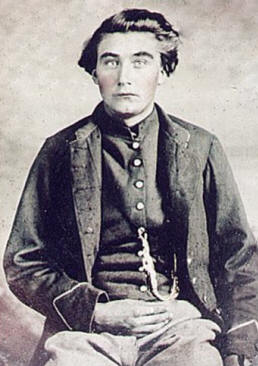In Greene County
Compiled by Cinda Byrd Deaton

The Bridge Burnings
In Greene County
Compiled by Cinda Byrd Deaton

In October 1861, William Carter, with the personal blessings of Abraham Lincoln
and General George McClellen (at a meeting at the White House on September 12),
had a plan to destroy the Confederate railroad supply route from Atlanta to
Richmond and points west, via East Tennessee.
On his return trip to Knoxville, Carter stopped to inform General George Thomas,
training a Federal army in Lexington, Kentucky, of his plans, and Captain David
Fry, Second East Tennessee (US) Volunteers, then training in Kentucky, was
assigned to assist him.
From their base in Knoxville, the two men began to raise a pro-Union Home Guard
unit to accomplish the mission, and on November 8, the unit was divided into 8
groups, each group assigned to destroy a certain railroad bridge, and on
November 13, Carter reported to General Thomas, back in Kentucky, that 6 to 8
bridges had been destroyed. (Only five had actually been destroyed.)
Unfortunately for the Unionists, despite the pleadings of Carter, General Thomas
refused to move troops to support East Tennessee, although the support would
have probably been too late for the raiders.
Maine-born Confederate Colonel David Leadbetter received word that the
"Unionists" were gathered near Newport, Tennessee, and, splitting his command,
managed to surround the Union men, capturing nearly 400, which included Senator
Andrew Johnson's son-in-law (Judge David T. Patterson), as well as several
members of the State Legislature.
At the personal orders of Judah P. Benjamin, Confederate Secretary of War, the
five leaders were to be hanged, their bodies to be left hanging near the
railroad tracks to impress other "would-be" Unionists, but Captain Fry escaped,
and the four that were hanged were buried within 18 hours, as the heatwave made
long term display unpleasant.
Two days later, the pro-Union Knoxville Whig publisher William "Parson" Brownlow
was arrested and jailed in Knoxville on charges of inciting "the rebellious
actions of November 8." (A month later, Brownlow was escorted to Union lines,
and released, where he continued to speak out against the South's secession.)
While in jail, Brownlow was informed that "some 400 men captured at Newport"
were being sent under a strong guard to the prison in Tuscaloosa, Alabama, "to
remain until the hostilities between the Union and the Confederates cease."
Thirteen months later, those remaining in prison were exchanged for a like
number of Confederate prisoners, and the Unionists made their way through East
Tennessee to Kentucky, to form the Fourth East Tennessee (US), Volunteer
Infantry Regiment in an army commanded by General George Morgan. (The 1st, 2nd,
and 3rd East Tennessee regiments and several East Tennessee Cavalry units were
already organized into that army.)
By March of 1863, the 4th was already actively working as part of the occupying
force in the Cumberland Gap, even though the regiment was not officially
mustered into the Union army until June of 1863, and officially dropping the
"East" from their name, as the State of East Tennessee was no longer a
possibility. (West Virginia had an ample supply of Union forces in her
boundaries to be able to support her separation from the state of Virginia, but
by the time enough troops were in Tennessee, the separation was no longer
necessary.)
The 4th was also one of several regiments that weren't being paid, as Paymaster
General Mansfield could not send pay until the regiments were at full strength,
and without pay, recruiting was extremely difficult.
My great-grandfather was one of the men of the 4th Infantry, Company D. In this
unit was a man named Grayson, who is named in the song "Tom Dooley, and
a movie was made of the same name, starring Michael Langdon.
JAMES BIRD/BYRD was born January 1843 in Grainger County, Tennessee, and died 15 February 1895
in Clay County, Kentucky. He married CATHERINE McDaniel 21 September 1868 in
Tazewell, Tennessee. She was born July 1852 in Clay County, Kentucky, and died
26 September 1942 in Hamilton, Ohio. They are both buried at Corinth Church
Cemetery, Saddler, Clay County, Kentucky. James served for the Union Army in the
4th Tennessee Volunteer Infantry, Company D. He was in the civil war fighting on
the Union side, after being threatened in Hawkins County, Tennessee, because he
would not join Rebel forces. He and My great-great Grandpa, Thomas Bird, safely
took the family to Clay County Kentucky, leaving in the middle of the night,
with all their belongings in wagons pulled by oxen and horses, crossed the
Cumberland Gap into Kentucky, and on to Clay County, Kentucky. They changed the
spelling of the name so that they could not be found. James then went back and
joined the Union forces in Tennessee, getting first cousins Francis M. Bird and
Jacob N. Bird to also join. He later married Catherine McDaniel in 1868,
stealing her from her fathers house, and riding horseback to his sister Louisa's
in Tennessee where they were married. Catherine said her father would have
hanged him if they had been caught. She was only fifteen. The family still uses
Byrd as the spelling. This is documented by James pension files, and by census,
1850 in Grainger County, Tennessee, 1860 in Hawkins County, Tennessee, and 1870
in Clay County, Kentucky, and stories told to me by my sister about our Great
Grandma, Catherine. She lived to be 94 years old. They are my Great
Grandparents.
Sources:
Personal research notes of and contributed by Dennis Michael O'Neill
Pension file and personal notes of Cinda Byrd Deaton
The OR (Washington, 1901)
The Papers of Andrew Johnson (Vol. IV and V)
The Papers of Abraham Lincoln (Vol. III)
The Knoxville Whig newspaper, dated November (?), 1861
The East Tennessee Historical Society, Knoxville, Tennessee
The Greene County Historical Trust, Greeneville Tennessee
University of Tennessee Knoxville
Department of History, East Tennessee State University, Johnson City, TN
Knox County Library System (McClung Historical Collection), Knoxville